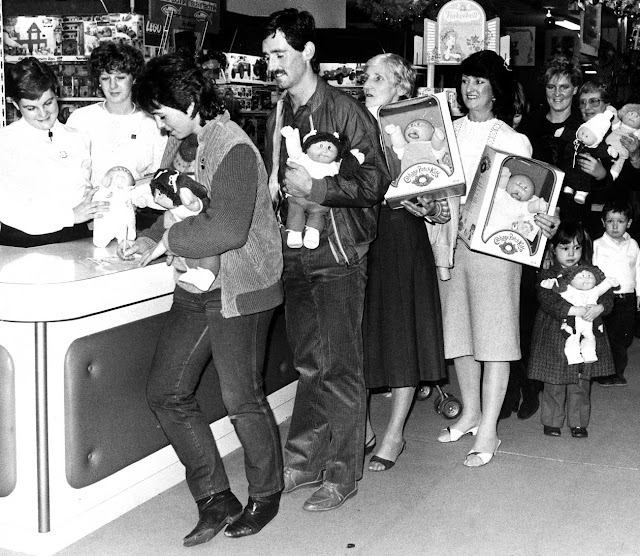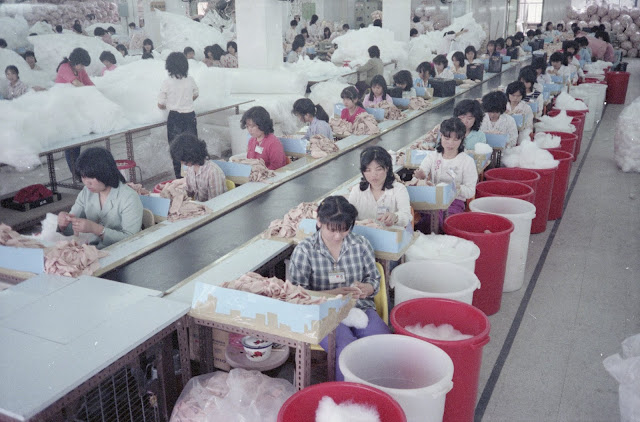In the history of all Christmases that have come to pass, there never was another that so turned the American consumer into a stark raving lunatic like the Cabbage Patch Kids craze of 1983.
During the 1983 holiday season, 3 million Cabbage Patch Kids were sold. After Black Friday, stores were sold out across the country and frustrated shoppers were in revolt. News stories documented near riots at shopping malls and retail stores across the country: a pregnant woman trampled by a crazed mob, a shopper who broke her leg in a scuffle, another who was knocked unconscious in a customer rush.

|
| At Hamleys, the top London toy store, hundreds of people clamored for the dolls when the store opened at 9:00am on December 3rd. |
The original dolls weren’t called Cabbage Patch Kids at all; they were called “Little People” and were the creation of Xavier Roberts, a Georgia artist. Xavier made his dolls like his mother made quilts. Each one was handmade, and he signed their butts with a permanent marker — later, some of them would come to be stamped (or signed and stamped).
As the “Little People” grew in popularity, he opened Babyland General, a doll hospital that specialized in adopting out “Little People.” Xavier still made each doll, but his staff dressed up in medical attire and helped families pick their perfect new addition. These dolls came with a slew of adoption paperwork which was all very official and marked them as a Babyland General official “Little People.”
These original dolls have some really distinctive things about them that set them apart and make them particularly valuable. Original “Little People” were completely soft, even the heads — later when they rebranded as Cabbage Patch Kids, they gained vinyl noggins. They also had a huge thumb which was a signature of Xavier originals. The final detail is that every single one of the early dolls was hand-signed by Xavier himself. Later in the line, they were stamped, and most, if not all, of these signatures, had an associated date which makes year identification easier!
In 1982 Coleco was given the right to produce “Little People” under a new name, Cabbage Patch Kids. They created what most people remember as Cabbage Patch Kids from their childhood — the vinyl headed, soft-bodied, yarn-haired dolls that sold in stores all over the world.
“What we are experiencing is an unprecedented consumer demand for the dolls,” said a Coleco spokeswoman.
To satisfy the demand, Coleco promised to increase production significantly, but many store owners across the country were telling disappointed shoppers that more than likely they would not ever have enough to meet demand before Christmas.
 |
| Hamleys toy store, London |
 |
| Hamleys toy store, London |
 |
| Hamleys toy store, London |
 |
| Hamleys toy store, London |
 |
| Hamleys toy store, London |
 |
| Shoppers queue to “adopt” Cabbage Patch Kids in the U.K. in November 1983. |
 |
| Security was tight at this “adoption center” in Manchester, England, in 1983. The Cabbage Patch craze had already caused riots in America. |
 |
| Brinks guards in Toronto escort a Cabbage Patch Kid to its new owners, who paid $5,600 in an auction to help the Hospital for Sick Children. |
 |
| The Cabbage Patch Kids have left the building. |
 |
| Chinese workers stuff and sew Cabbage Patch Dolls in a Shenzhen factory in 1983. |
 |
| Newsweek, December 12, 1983. |
 |
| A range of the Dolls. |

|
| Xavier Roberts sits in a pile of the Cabbage Patch Dolls that he created. |



